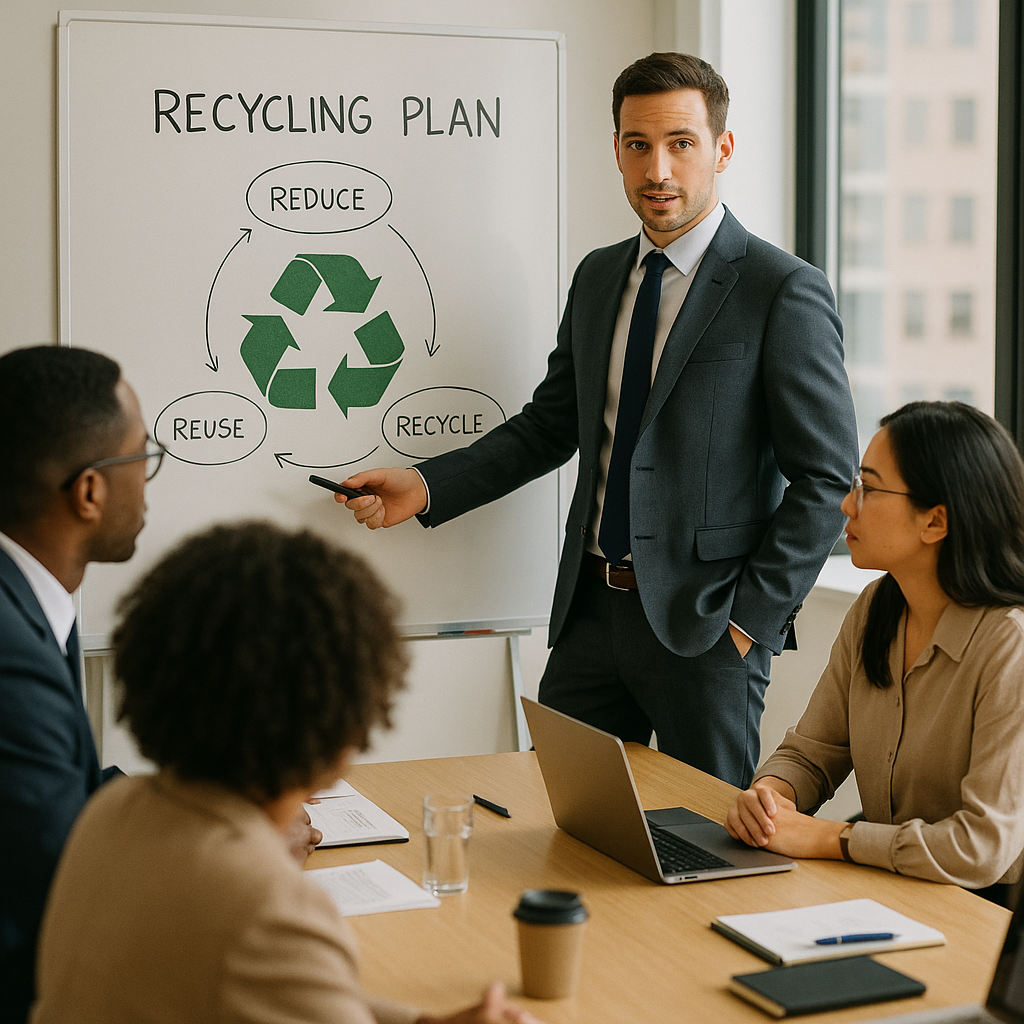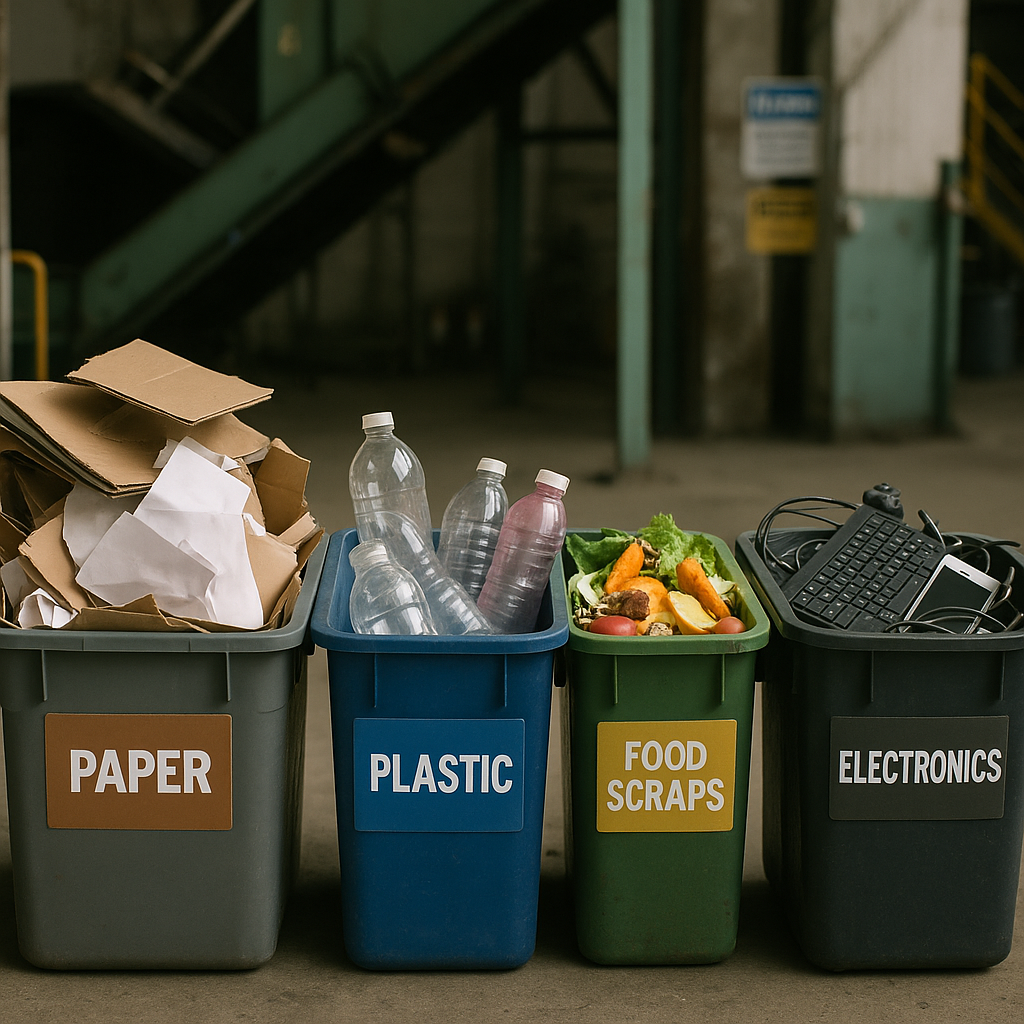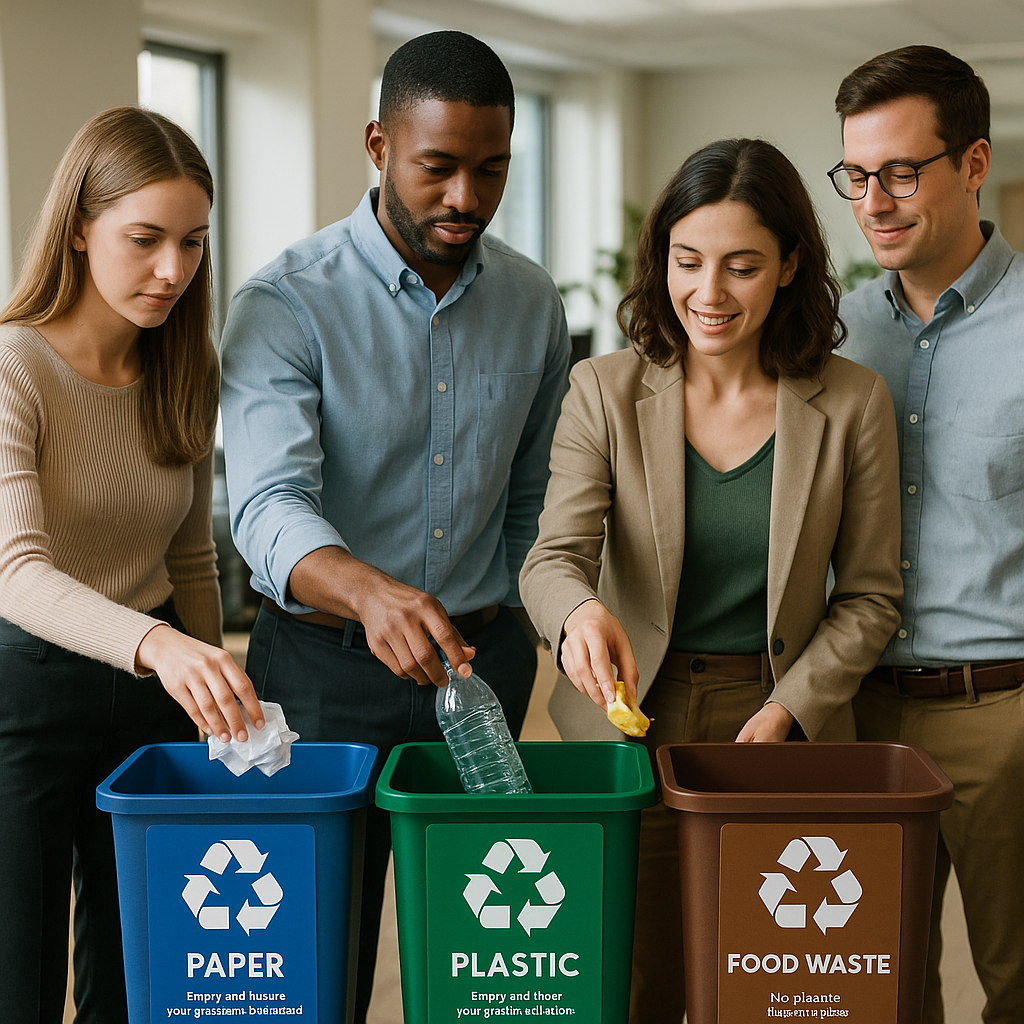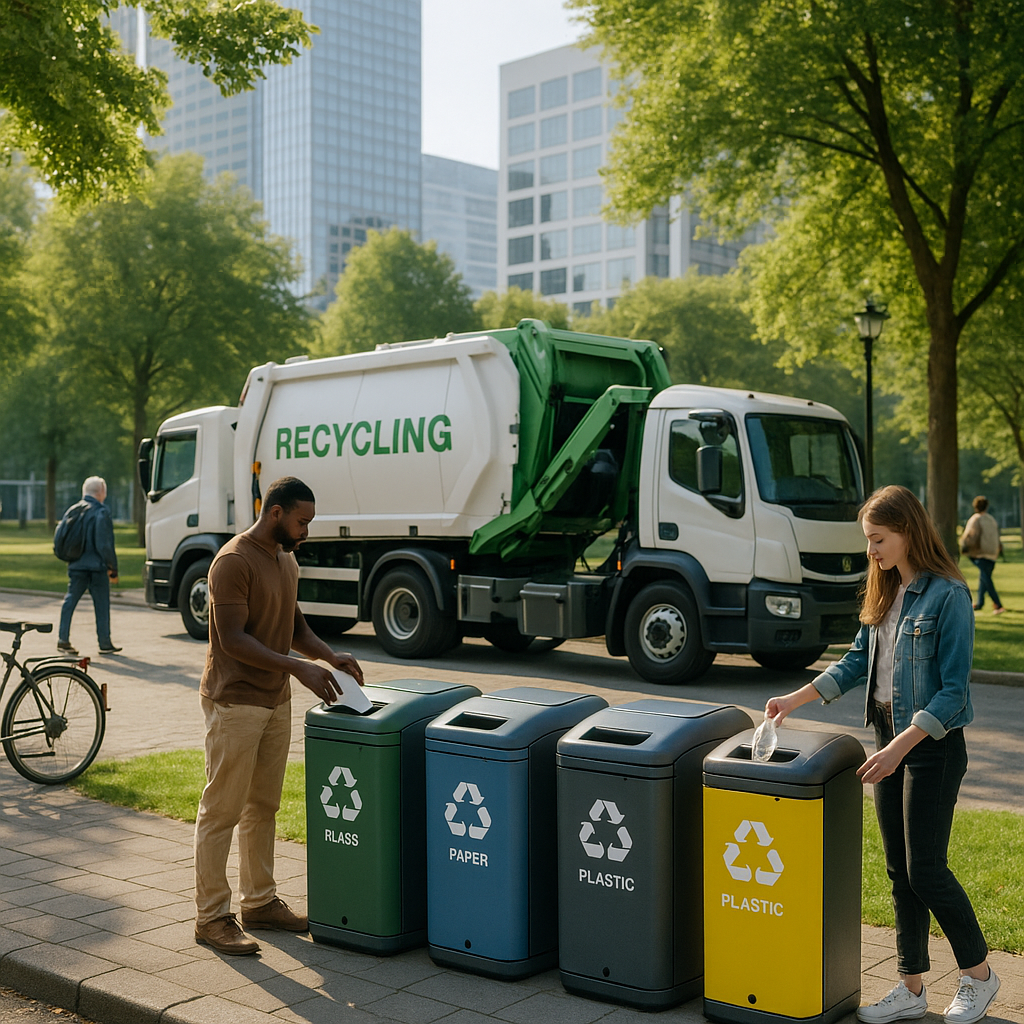5901 Botham Jean Blvd, Dallas, TX 75215
Waste Stream Management: A Complete Guide for Businesses and Communities
July 12, 2025Waste stream management is the systematic process of handling waste materials from their point of origin to their final destination. It involves more than just discarding items—it’s a comprehensive approach that includes the collection, transportation, processing, recycling, and disposal of various waste materials.
At its core, waste stream management aims to minimize negative impacts on the environment and health while recovering valuable resources from discarded materials. When implemented effectively, it transforms waste from a burden into an opportunity for resource recovery and value creation.
Waste stream management is a crucial environmental service that influences our daily lives, often without our awareness. The systematic handling of waste affects everything from public health and environmental protection to resource conservation and economic development. As we encounter increasing waste volumes, proper management systems become even more essential for fostering sustainable communities.
What Are the Key Components of Waste Stream Management?

Effective waste stream management functions as an interconnected system with several critical stages. Each component must operate effectively to ensure waste materials move efficiently from generation to final disposal. Let’s explore these key elements in detail.
Waste Generation
This initial stage marks the point where materials enter the waste stream, encompassing all discarded items from homes, businesses, institutions, and industrial facilities. The volume and composition of waste generated can significantly vary by source.
Residential areas often produce household waste, including food scraps, packaging materials, and everyday consumer items. Commercial entities generate paper, cardboard, and specialized waste related to their operations. Industrial facilities create process-specific waste that may include chemicals or manufacturing byproducts.
Understanding waste generation patterns enables managers to develop targeted reduction strategies. Many municipalities now implement waste reduction education programs to decrease the overall volume entering the system.
Waste Collection
Once generated, waste must be systematically collected for proper management. This component involves gathering waste from its source and transporting it to processing or disposal facilities.
Collection methods vary widely. Curbside pickup serves residential areas with regular schedules for different waste types. Commercial properties often use dumpsters with specialized collection vehicles. Industrial facilities may require custom collection systems for their unique waste streams.
The logistics of collection must consider factors like route efficiency, vehicle emissions, and worker safety. Modern collection systems increasingly utilize data analytics to optimize routes and reduce environmental impact.
Sorting and Processing
After collection, waste materials undergo sorting and processing to separate different materials for appropriate treatment. This crucial step determines which materials can be recovered and which require disposal.
Material Recovery Facilities (MRFs) employ various techniques to sort waste, such as manual sorting, mechanical screens, optical sensors, and magnetic separators. Advancing technology, like AI-powered systems, is enhancing sorting accuracy.
Processing may involve size reduction through shredding or crushing to prepare materials for the next stage. Some facilities use biological treatment methods for organic waste, converting it to compost or biogas.
Recycling and Resource Recovery
This component focuses on extracting value from waste materials. Recycling transforms discarded items into raw materials for manufacturing new products, reducing the need for virgin resources.
Paper becomes new paper products, plastic containers transform into carpet fibers or new packaging, metal cans return as construction materials, and glass bottles become new containers or construction aggregates.
Resource recovery extends beyond traditional recycling to include energy recovery from waste. Waste-to-energy facilities capture heat from combustion to generate electricity. Anaerobic digestion systems convert organic waste into biogas for power production.
Final Disposal
Materials that cannot be recycled or recovered ultimately require safe disposal. This final component ensures remaining waste causes minimal environmental harm.
Modern landfills feature engineered systems, including liners to prevent groundwater contamination, leachate collection systems to manage liquid runoff, and gas collection systems to capture methane emissions. Regulations require ongoing monitoring to ensure environmental protection.
Some non-recyclable waste may undergo thermal treatment through incineration, significantly reducing volume while capturing energy. Advanced air pollution control systems minimize emissions from these facilities.
Hazardous waste requires specialized disposal methods following strict protocols to neutralize harmful properties before final placement in secure landfills.
Each component in the waste stream management system depends on the others. A breakdown in any area affects the entire process. For instance, poor sorting reduces recycling effectiveness, while inadequate collection leads to illegal dumping and environmental damage.
As waste management evolves, integration between these components continues to improve. Digital tracking systems now monitor waste from generation through final disposal, creating more transparent and accountable management systems.
What Are the Different Types of Waste Streams?

Waste streams encompass the entire journey of waste from its origin through collection to final disposal or recycling. Understanding these streams is crucial for effective waste management planning, as each type requires specific handling based on its composition and environmental impact.
The municipal solid waste stream is most familiar to households and communities, consisting of everyday items like food scraps, packaging materials, paper products, and discarded goods. This waste usually enters the system via residential collection services, accounting for about 10% of all waste treated in the European Union.
Industrial waste arises from manufacturing and commercial activities, including factory byproducts, excess materials from production, and specialized sector waste. Such waste often contains recoverable materials, making sorting and processing essential for conserving resources.
Construction and demolition waste is one of the largest waste streams by volume, including concrete, wood, metals, drywall, and other materials from construction, renovation, or demolition. This stream offers significant recycling opportunities as many materials like metal, wood, and some aggregates can be reused in new constructions.
Hazardous waste requires specialized handling due to potential risks to health and the environment. It includes chemical waste, solvents, certain paints, pesticides, and materials with heavy metals or toxic substances. Strict regulations manage its transportation, storage, and disposal to prevent contamination and ensure safety.
Electronic waste, or e-waste, is rapidly growing, increasing by 3-5% annually. It includes discarded electronics, appliances, and equipment rich in valuable and potentially harmful materials. Large appliances make up nearly half of all e-waste by weight, with IT equipment and consumer electronics each comprising about 20%.
Liquid waste streams differ from solids as they’re characterized by physical state instead of source. This includes sewage from toilets and sinks, trade waste, and hazardous liquids needing special disposal. Each type follows distinct treatment paths in waste management systems.
Glass waste primarily comes from packaging, responsible for about 65% of all glass in the EU. With a recycling rate of around 70% for container glass, this stream underscores circular material use potential, saving approximately one-third of the energy needed for raw production.
Paper and cardboard waste is another major stream with high recycling potential. In the EU, 54% of the paper industry uses recovered materials, collected from trade (50%), households (40%), and offices (10%). Most recycled paper produces newspapers and packaging.
Plastic waste streams encompass numerous polymers with varying recyclability, with packaging as the largest source at nearly 40% of all plastic demand, followed by construction materials at about 20%. Despite advances, plastic waste management faces challenges due to material complexity and contamination.
Biowaste streams include biodegradable materials like food scraps and yard waste. These can be managed through composting or anaerobic digestion, generating resources like compost or biogas. The EU Landfill Directive aims to reduce landfill biowaste, recognizing its resource potential and environmental impact when mismanaged.
Why is Effective Waste Stream Management Important?
Effective waste stream management is a cornerstone of environmental stewardship and sustainable development. Beyond simply handling garbage, proper waste management protects natural resources and provides tangible benefits to communities and economies.
The environmental impact of mismanaged waste can be severe. If waste isn’t properly handled, harmful substances can leach into soil and groundwater, contaminating ecosystems and drinking water supplies. Improper disposal also releases methane and other greenhouse gases that significantly contribute to climate change. By implementing structured waste management, we can mitigate these pollutants and minimize environmental degradation.
Environmental Protection Benefits
The environmental case for effective waste management is compelling. Well-managed waste streams help prevent pollution of air, water, and soil resources, which are the foundation of healthy ecosystems. Properly sorted, processed, and disposed waste significantly reduces contamination risks to surrounding habitats.
Proper waste management also safeguards wildlife that might otherwise consume or become entangled in improperly disposed waste. Marine environments particularly benefit, as effective waste management helps reduce the estimated 8 million metric tons of plastic entering oceans annually.
The climate impact is equally crucial. Landfills are a major source of methane emissions, which have a warming potential 25 times greater than carbon dioxide. Through waste diversion, recycling, and modern landfill technology, these emissions can be significantly reduced or captured for energy generation.
Public Health Safeguards
The connection between waste management and public health is direct and significant. Inadequate waste disposal creates breeding grounds for disease vectors like mosquitoes, flies, and rodents, which can spread illnesses such as dengue fever, malaria, and leptospirosis.
Proper waste management also prevents exposure to hazardous materials that can cause respiratory issues, skin infections, and various chronic diseases. Communities with effective waste systems generally experience lower rates of waterborne disease outbreaks and reduced healthcare costs.
The COVID-19 pandemic highlighted another crucial aspect of waste management: the safe handling of medical and biohazardous waste. Effective systems ensure these potentially dangerous materials are treated appropriately before disposal.
Resource Conservation Advantages
Resources are finite, making conservation through waste management increasingly important. Recycling aluminum saves 95% of the energy required to produce new aluminum from raw materials. Similarly, recycling paper cuts energy usage by 60%, while preserving forests that act as carbon sinks.
Effective waste management supports the circular economy model, where materials remain in use rather than being discarded after a single use. This approach extends the useful life of materials, reducing the need for virgin resource extraction and processing.
Water conservation also benefits from proper waste management. By preventing leachate from entering groundwater systems, we protect valuable freshwater resources. Some advanced waste management facilities even capture and treat wastewater, returning it as a usable resource.
Economic Opportunities
The economic case for waste management is compelling. The global waste management market is projected to reach $530 billion by 2025, creating significant job opportunities across collection, processing, recycling, and administration sectors.
Communities with effective waste management systems typically enjoy reduced municipal costs through lower landfill tipping fees and extended landfill lifespans. Businesses benefit from resource recovery opportunities and lower disposal costs when waste streams are properly managed.
Waste-to-energy technologies represent another economic advantage, generating electricity from materials that would otherwise occupy landfill space. These facilities create permanent technical jobs while producing renewable energy that can offset fossil fuel consumption.
Well-managed waste streams also enhance tourism and property values. Clean environments attract visitors and investment, while property values remain higher in communities with effective waste management infrastructure.
Social and Community Benefits
Beyond environmental and economic factors, proper waste management brings important social benefits. Clean communities foster civic pride and an improved quality of life. Effective systems promote environmental justice by ensuring waste facilities don’t disproportionately impact vulnerable populations.
Waste management also provides educational opportunities about sustainability and environmental stewardship. Community recycling programs, composting initiatives, and waste reduction campaigns build awareness and encourage responsible consumption habits.
The social cohesion that develops through community-based waste management initiatives shouldn’t be underestimated. Neighborhood clean-ups, recycling drives, and shared composting facilities unite people around common goals.
Effective waste stream management is crucial at the intersection of environmental protection, public health, resource conservation, and economic opportunity. As global waste generation continues to rise, the importance of implementing and maintaining proper management systems becomes increasingly critical. Through thoughtful waste policies and individual actions, we can transform waste from an environmental liability into a valuable resource stream that benefits communities, economies, and ecosystems.
How Can Businesses Improve Their Waste Stream Management?

Effective waste stream management is not only an environmental concern but also a strategic business necessity. Companies that refine their waste management processes often find significant cost savings while enhancing their environmental image. By implementing structured waste handling approaches, businesses can transform what was once a necessary expense into an opportunity.
Conduct Comprehensive Waste Audits
A waste audit is the cornerstone of any effective waste management strategy. This systematic assessment reveals precisely what materials are discarded, in what quantities, and from which operational areas. The insights from a thorough waste audit enable data-driven decisions about waste streams.
To conduct an effective waste audit, businesses should collect, sort, and analyze waste over a set period. This process typically involves examining waste from different departments to identify patterns and troublesome waste sources. Many companies discover that recyclable materials constitute a significant portion of their general waste.
Texas Instruments implemented a waste audit that revealed 40% of their factory waste was recyclable. By adjusting processes accordingly, they saved $215,000 annually in disposal costs. Similarly, Dell Technologies in Round Rock, Texas reduced their landfill waste by 78% through detailed waste audits, saving $340,000 each year.
Develop and Implement Waste Reduction Plans
After identifying key areas for improvement through a waste audit, businesses should develop targeted waste reduction strategies. These plans are most effective when they include specific, measurable goals with clear timelines and assigned responsibilities.
Effective waste reduction plans typically include:
- Source reduction strategies to minimize waste before it’s created
- Reuse protocols for multipurpose materials
- Improved recycling systems with clear signage and employee training
- Composting programs for food waste and organic materials
Prioritize waste reduction opportunities based on their return on investment. Focus initially on high-volume materials like paper, cardboard, and food waste for the easiest gains. Companies with structured waste reduction plans often see a 30-40% reduction in disposal costs within the first quarter.
Ensure Regulatory Compliance
Waste management regulations vary significantly by location and industry. Understanding and complying with these requirements is essential to avoid fines and operational disruptions. Businesses should stay informed about regulations from local municipalities, state agencies like the Texas Commission on Environmental Quality (TCEQ), and federal bodies such as the EPA.
Key regulatory considerations include:
- Proper handling and disposal of hazardous materials
- Documentation requirements for waste disposal
- Special protocols for industry-specific waste streams
- Extended producer responsibility regulations
Many companies find value in conducting regular compliance audits alongside their waste assessments to prevent potential problems. Lockheed Martin’s Fort Worth facility maintains a proactive approach to compliance by integrating these requirements into waste reduction initiatives.
Implement Waste Tracking Systems
You can’t manage what you don’t measure. Consistent tracking methods help businesses monitor progress and identify areas needing attention. Modern tracking can range from simple spreadsheets to sophisticated software platforms providing real-time waste data.
Effective tracking systems should monitor:
- Total waste volumes by category (landfill, recycling, composting)
- Contamination rates in recycling streams
- Cost per ton for different disposal methods
- Progress toward waste reduction goals
Toyota’s San Antonio plant discovered through tracking that metal scraps made up 35% of their waste stream. By establishing dedicated recycling programs for these materials, they generated $180,000 in revenue from previously discarded materials. Their tracking systems continue to identify waste diversion and cost savings opportunities.
Partner with Waste Management Experts
Specialists in waste management offer valuable expertise and resources to help businesses optimize waste streams. These partners can provide guidance on best practices, assist with waste audits, and offer specialized services for unique challenges.
When selecting a waste management partner, businesses should consider:
- Experience in their specific industry or with similar waste streams
- Knowledge of local regulations and recycling infrastructure
- Ability to provide comprehensive waste services
- Commitment to sustainability and continuous improvement
A medium-sized plastic parts producer in Houston reduced waste by 52% after partnering with waste management consultants, identifying recyclables within their waste stream, and optimizing collection systems, thereby reducing disposal costs by $75,000 annually.
Engage Employees in Waste Reduction Efforts
Employee participation is crucial for successful waste management. Staff who understand the significance of proper waste handling and feel invested in sustainability goals are more likely to adhere to protocols.
Strategies for effective employee engagement include:
- Clear communication about waste reduction goals and progress
- Targeted training on proper sorting and disposal practices
- Recognition programs rewarding waste reduction innovations
- Creation of green teams with representatives from various departments
Companies with a culture of sustainability find that employee-led initiatives often drive substantial improvements in waste management. Regular updates on progress keep staff motivated and invested in the company’s environmental goals.
Conclusion: The Future of Waste Stream Management

The landscape of waste management is evolving quickly. Industry leaders are moving away from traditional disposal methods toward circular economy principles that view waste as a valuable resource. This shift necessitates new technologies, collaborative approaches, and innovative policies. Recent global waste management reports indicate that adopting circular economy practices could transform current costs into net gains of over $100 billion annually by 2050.
Effective waste stream management in the future depends on technological innovation, policy development, and global cooperation. As waste generation increases worldwide, integrating advanced sorting technologies, comprehensive recycling programs, and international waste reduction frameworks becomes crucial. This is not just an environmental concern but also an economic and social imperative affecting communities across the globe. For guidance on implementing sustainable waste management practices or to explore recycling solutions for your organization, contact Okon Recycling at 214-717-4083.
